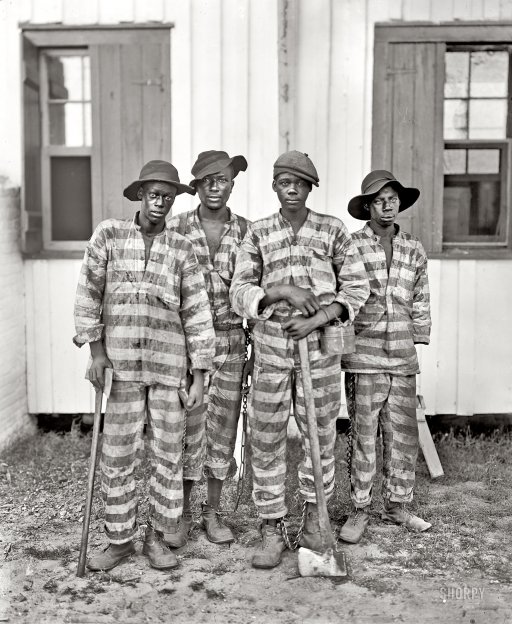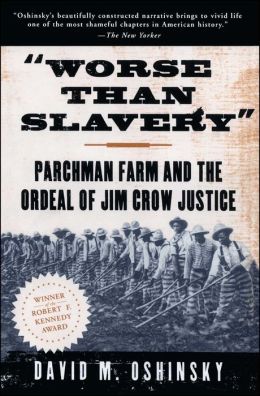
From a Washington Post Book Review, "In the Fields of Despair," by Jonathan Yardley, 31 March 1996 -- The second part of David Oshinsky's subtitle tells what his book is really about: the post-Civil War perversion of justice in the American South, not merely at Mississippi's infamous Parchman Farm but also in the region as a whole, in state-run prisons and in vigilante bands taking public matters into private hands. That it is a terrible story is well-known to students of the South specifically and the United States generally; but only now do we have the full telling, in this careful and -- the word is used advisedly -- horrifying book.
Oshinsky is a professor of history at Rutgers University in New Jersey. A generation ago this would have subjected him to charges of regional bias if not flat-out anti-South prejudice, but now that there are strong and non-ideological Southernstudies specialists in many distinguished universities outside the region that charge is far harder to sustain. From the evidence presented in Worse Than Slavery, Oshinsky set out not to prove a point but to find the truth.

Worse Than Slavery: Parchman Farm and the Ordeal of Jim Crow Justice, by David M. Oshinsky
His focus is on Mississippi, by the 1830s "a place of violent moods and minimal restraint, where passion took precedence over the law." This characteristic deepened over the years and, after the Civil War, exploded into anti-black violence that had nothing to do with justice and everything to do with racial fear and hatred. One of the worst early incidents took place in 1871 in the town of Meridian, where the Ku Klux Klan killed more than two dozen blacks, "all the leading colored men of the town with one or two exceptions," in the account of an early history of Reconstruction in Mississippi. As Oshinsky puts it:
"Meridian set the stage for a full-blown epidemic of racial violence in the South. And Mississippi, with its vigilante tradition and vulnerable black majority, would lead the region in every imaginable kind of mob atrocity: most lynchings, most multiple lynchings, most lynchings of women, most lynchings without an arrest, most lynchings of a victim in police custody, and most public support for the process itself. Widely defended as the only effective deterrent against the murder and rape of white women by Negro men, mob violence would be directed at burglars, arsonists, horse thieves, grave robbers, peeping toms and trouble-makers -- virtually all of them black."

Well into the 20th century mob violence was openly countenanced, sometimes actively encouraged, by the highest public officials in the state, most notoriously Gov. James K. Vardaman, who said that constitutional protections "did not apply to wild animals and niggers." For a long time Mississippi used black convicts in a leasing scheme with private industry that became "a functional replacement for slavery, a human bridge between the Old South and the New." But the crimes committed against black convict labor under this system were so outrageous that finally not even Mississippi could stomach them, especially as less fortunate whites finally figured out that the sole beneficiaries of it were rich white employers.
The eventual replacement for convict leasing was Parchman Farm, a 20,000-acre tract "in the Yazoo-Mississippi Delta, 90 miles south of Memphis, at a dilapidated railroad spur known as Gordon Station." In a bloody state, the Delta was the bloodiest place; a black scholar named Charles S. Johnson wrote in 1941 that "a common belief in Negro communities outside Mississippi is that it is the worst place in the entire country for Negroes." Cotton was king there: "The Delta became the realm of the planter and the tenant -- one white and powerful, mixing modern business techniques with ante-bellum dreams; the other black and vulnerable, tending the rich man's cotton for a fraction of the take."

Parchman Farm fit right into its milieu; it looked like a cotton plantation, not a prison, "with cattle barns, vegetable gardens, mules dotting the landscape and cotton rows stretching for miles." By 1915, a decade after it had been established, the farm was "a self-sufficient operation," with "a sawmill, a brick yard, a slaughterhouse, a vegetable canning plant and two cotton gins," the overall impression being of "an ante-bellum plantation with convicts in place of slaves." For the state of Mississippi it was "a giant money machine: profitable, self-sufficient and secure." For its imprisoned residents, 90 percent of them black, it was hell.
The men (and a handful of women) sentenced to Parchman worked in gangs, in endless days under the pulverizing Mississippi sun. Their nourishment was crude, filthy and germ-ridden. They were under the control of white sergeants and drivers and black trusties whose privileges rose in direct proportion to the cruelties they exacted upon their fellow blacks. Men were shot at whim, dragged through the heat until they collapsed and died, whipped into submission by "a leather strap, three feet long and six inches wide, known as 'Black Annie,' which hung from the driver's belt." Its victims suffered dreadfully:
"At Parchman, formal punishment meant a whipping in front of the men. It was done by the sergeant, with the victim stripped to the waist and spread-eagled on the floor. What convicts most remembered were the sounds of Black Annie: the 'whistlin' ' air, the crack on bare flesh, the convict's painful grunt . . . . When asked to defend Black Annie, Parchman officials did so with pride. The lash was effective punishment, they insisted, and it did not keep men from the fields. 'You spank a fellow right,' claimed a superintendent, 'and he'll be able to work on.' Most of all, Black Annie seemed the perfect instrument of discipline in a prison populated by the wayward children of former slaves. There simply was no better way 'of punishing [this] class of criminals,' said Dr. A.M. M'Callum, Parchman's first physician, 'and keeping them at the labor required of them.' "
In time Parchman, like convict leasing before it, came under unfavorable scrutiny, not merely from outsiders but even from a few white Mississippians who realized that the stain it splattered across the state might well become indelible. It ceased to be a farm and became yet another prison, albeit one with a singularly sordid past. David Oshinsky's chronicle of that past, and of the larger climate out of which Parchman emerged, is thoroughly scrupulous and, considering the subject matter, remarkably restrained. Readers should be warned, though, that the details with which his narrative is burdened are often sickening; one reads Worse Than Slavery with a sick stomach and an aching heart. (source: The Washington Post © 1996 The Washington Post Co.)




WOW
ReplyDelete